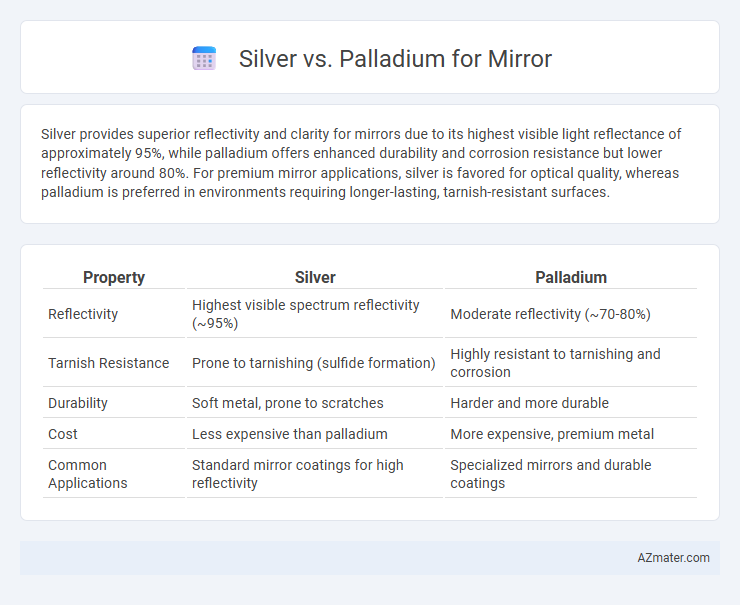Silver provides superior reflectivity and clarity for mirrors due to its highest visible light reflectance of approximately 95%, while palladium offers enhanced durability and corrosion resistance but lower reflectivity around 80%. For premium mirror applications, silver is favored for optical quality, whereas palladium is preferred in environments requiring longer-lasting, tarnish-resistant surfaces.
Table of Comparison
| Property | Silver | Palladium |
|---|---|---|
| Reflectivity | Highest visible spectrum reflectivity (~95%) | Moderate reflectivity (~70-80%) |
| Tarnish Resistance | Prone to tarnishing (sulfide formation) | Highly resistant to tarnishing and corrosion |
| Durability | Soft metal, prone to scratches | Harder and more durable |
| Cost | Less expensive than palladium | More expensive, premium metal |
| Common Applications | Standard mirror coatings for high reflectivity | Specialized mirrors and durable coatings |
Introduction: Silver vs Palladium in Mirror Manufacturing
Silver and palladium serve as key materials in mirror manufacturing due to their exceptional reflective properties. Silver offers the highest reflectivity across the visible spectrum, making it the preferred choice for traditional mirrors, while palladium provides superior corrosion resistance and durability in harsh environments. Advances in coating technology have enabled hybrid layers combining silver and palladium to optimize mirror performance for both clarity and longevity.
Chemical Properties Relevant to Mirrors
Silver exhibits superior reflectivity across the visible spectrum, making it the most efficient metal for mirror coatings due to its low absorption and high electrical conductivity. Palladium, while resistant to tarnishing and oxidation, has lower reflectivity and higher absorption in visible light, resulting in dimmer mirror performance. Chemically, silver's susceptibility to oxidizing agents requires protective overcoats, whereas palladium's inertness reduces maintenance but compromises optical clarity in mirrors.
Reflectivity Comparison: Silver vs Palladium
Silver offers superior reflectivity, reaching up to 95% in the visible light spectrum, making it the preferred choice for high-quality mirrors. Palladium, although more durable and resistant to tarnishing, has a lower reflectivity rate of around 70%-80%, resulting in less bright and crisp reflections. The higher reflectance and clarity of silver mirrors make them ideal for applications requiring optimal brightness and color accuracy.
Durability and Corrosion Resistance
Palladium offers superior corrosion resistance compared to silver, making it highly durable in environments prone to tarnish and oxidation. Silver, while more affordable, tends to tarnish quickly and requires frequent maintenance to maintain its reflective quality. The durability and low reactivity of palladium make it a preferred choice for long-lasting, corrosion-resistant mirrors.
Cost Analysis: Silver Mirrors vs Palladium Mirrors
Silver mirrors offer a cost-effective solution, with raw silver prices significantly lower than palladium, making them more affordable for large-scale or budget-conscious projects. Palladium mirrors, while costing substantially more due to the metal's rarity and market demand, provide enhanced resistance to tarnishing and corrosion, potentially reducing long-term maintenance expenses. Evaluating the total cost of ownership reveals silver mirrors as economically advantageous upfront, whereas palladium mirrors justify their higher initial expense through durability and extended lifespan in demanding environments.
Aesthetic Differences in Mirror Applications
Silver provides mirrors with exceptional reflectivity and a warm, slightly yellowish tint that enhances natural light and offers a classic, elegant appearance. Palladium coatings yield a cooler, more neutral reflection with a subtle grayish undertone, contributing to a modern and sophisticated look. The choice between silver and palladium mirrors depends on desired ambiance: silver excels in warmth and brightness, while palladium favors a contemporary, muted aesthetic.
Ease of Fabrication and Maintenance
Palladium offers superior ease of fabrication for mirrors due to its higher malleability and resistance to oxidation, allowing for smoother coatings and fewer defects during production. Silver provides excellent reflectivity but requires more frequent maintenance because it tarnishes quickly, necessitating protective coatings or regular cleaning to preserve mirror quality. Palladium's durability and lower reactivity reduce maintenance demands, making it a preferred choice in high-precision and long-lasting mirror applications.
Environmental Impact and Sustainability
Silver and palladium differ significantly in environmental impact and sustainability during mirror production, with silver often favored for its lower ecological footprint due to more established recycling processes and less intensive mining requirements. Palladium mining involves higher energy consumption and greater habitat disruption, posing sustainability challenges despite its superior corrosion resistance. Choosing silver contributes to more environmentally responsible mirror manufacturing, supporting circular economy principles and reducing resource depletion.
Common Uses and Industry Preferences
Silver is widely preferred in mirror manufacturing due to its superior reflectivity and cost-effectiveness, making it ideal for high-quality household and automotive mirrors. Palladium, while less common, is favored in specialized optical applications and luxury automotive mirrors for its corrosion resistance and durability. The glass and automotive industries primarily rely on silver mirrors for mass production, whereas niche sectors use palladium to enhance performance and longevity.
Conclusion: Choosing the Right Metal for Your Mirror
Silver offers unmatched reflectivity and a classic bright finish, making it ideal for traditional mirrors requiring high clarity and brilliance. Palladium, while slightly less reflective, provides superior corrosion resistance and durability, perfect for mirrors exposed to humid or harsh environments. Selecting between silver and palladium depends on the mirror's intended use, balancing visual brilliance with long-term maintenance needs.

Infographic: Silver vs Palladium for Mirror
 azmater.com
azmater.com